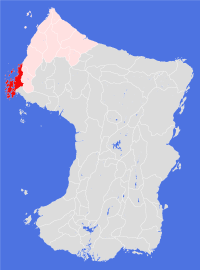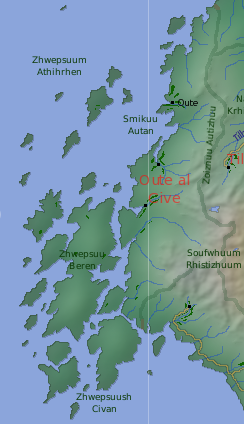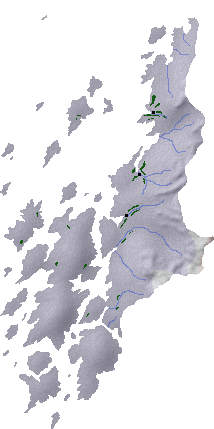Oute al Cive

Societal ties: Bartak
Current population: 1
Main language(s): Dam Bathtel, Oute
Area: 177,000km²
Natural and political borders
The natural borders of this coastal Land are the Soufwhuum Rhastizhuum and Zoiznuu Autizhuu.
The coastal areas between latitudes 32.2°N and 39.7°N are considered to be part of the Land, though only the northern border has any political weight.
History
The Oute coastlands and the offshore islands that comprise this Land have only intermittently been inhabited - the oldest extant settlement was established in the gt840s. For the first three centuries only outcasts and malcontents attempted to live in this area - little remains to mark their time among the volcanoes.
The useful properties of the volcanic soils in this area were discovered in the late gt820s, and mining first started as a seasonal operation in the early gt830s. A more permanent settlement - Oute, funded in the first instance by Omne interests - became viable in gt845. Landslides destroyed the early settlement in gt859 and gt883, but the settlement has managed to avoid calamity since its re-establishment in gt892. Other Bartak Lands have set up similar settlements since the gt850s, but the only long-term viable settlements have been those established by the Oute settlers themselves.
During the gt950s, various Pentuuk Society companies also began mining the volcanic soils for various uses. Initially this activity was confined to the the southern flanks of the large volcanoes in the Land of Horhe. When that Land began to tax the companies on the volume of material extracted, the companies began to look further afield for sources. In gt962 Tosnha Conglomerates (based in the Land of Penin-Syuule) sent company forces to forcibly take over Two seasonal camps in Zhwepsuush Civan; further occupations took place in gt963, and in the autumn of that orbit Oute settlement itself was invaded, with the settlers placed under Company Law.
It took the Bartekol League 2 orbits to arrange a response; in gt965 a joint task force of ships and land forces were sent to the area to liberate the settlers and arrest the occupiers. Resistance was fierce, but short lived; company staff were taken to Ohmne to stand trial.
There followed an extraordinary pantomime of diplomatic intrigue and farce, based around the central question of whether the Bartekol League had any jurisdiction over the volcanic region. Several times, various Pentuuk Lands threatened to go to war with the League, but there was no substance to the threats and they were ignored. More importantly, in gt969 a force of mercenary ships paid for by a group of companies led by Tosnha Conglomerates attempted to blockade the western Bartak ports - without success, though this action had a severe effect on Bartak-Pentuuk trade relations for several decades.
In gt970, the Bartekol League took the step of recognising the four extant settlements in the volcanic region as a Land in its own right, and admitted the new Land to the League. In gt972 The Land of Horoh - the westernmost Pentuuk Land - formally recognised the new Land as a sovereign entity, and within an orbit the diplomatic crisis was over.

Politics and economy
The Land has been settled principally to mine the volcanoes for rocks and minerals. The volcanoes produce ash and pumice which weather into a mineral-rich soil perfect for cultivation. Aggregates mining has proved to be a profitable venture for those willing to risk their money and their lives in the endeavour.
The ethnic makeup of the Land's population is mixed, and fluctuates with the seasons. In addition to the three permanent settlements, there are a number of seasonal settlements occupied only during the summer - the numbers and locations of these settlements varies orbit by orbit. Most of the permanent population - around 85 per cent - is Bartak, with a slim majority of these being native-born. The rest of the permanent population is Pentuuk, mainly originating from Horoh, but also from other coastal Pentuuk lands. In the summer months the population of the Land trebles, with over 70 per cent of the seasonal migrants being Pentuuk.
With such large demographic changes occurring annually, Oute al Cive politics has a unique flavour. The Land is a centralised democracy, with two elected chambers - the permanent chamber is elected for terms of between 5 and 7 years (depending on the strength of the party in power), with a second, advisory chamber elected each autumn by those who have worked the season but are not resident. Most legislation takes place in the winter months, when mining is too dangerous.
Exported soils are taxed to pay for both basic infrastructure and for a permanent security forces - which is drawn mainly from the permanent population with a significant number of Lejune and Horoh mercenaries. Pentuuk companies are allowed to retain their own security in seasonal mining sites they operate, but may only employ people who have served a minimum of three orbits in the Land forces.
Culture and other issues of interest
Permanent settlers and migrant workers tend not to live alongside each other - indeed most migrant workers live and work in the seasonal camps. However, the Pentuuk minority living in the permanent settlements do mix more, and play a significant role in the cultural activities of the settlements.
Stereotypical activities for the native Oute-Cive are drinking, fighting and digging. This is frankly derogatory; the permanent population take pride in learning and education, and behind the walls of their houses, halls and temples have developed a vibrant culture where poetry, storytelling, music and the visual arts are highly esteemed. With the recent revolution in communications technologies, people across the Bartak, Pentuuk and even Ambostak Societies are beginning to realise this, and Oute-Cive art and music has been at the leading edge of cultural development in these Societies for over twenty orbits now.
The official language of the Land is Dam Bathtel; but for everyday purposes most permanent settlers speak a creole (known locally as Oute) - a simplified Bathtel grammatical structure with a lexicon of words derived from both Penin and Bathtel.
Key natural features
Oute al Cive is a land of volcanoes. For millions of years a volcanic hot spot has been moving westwards (or, more accurately, the continental plate has been travelling east across the hot spot), creating Soufwhuu Horhizhuu (believed to be extinct) and the Soufwhuum Rhistizhuum. The newest additions to the family are Zhwepsuush Civan, Zhwepsuu Beren and Zhwepsuum Athihren (though these last islands may be the result of tectonic subduction further west).
Much of the volcanic activity is explosive in nature, with little in the way of magma flows. Some explosions can be massive, with accompanying pyroclastic flows. However, what makes this land so inimical to human habitation is the combination of loose ash and rock with heavy rainfall, resulting in devastating mudflows and landslides.

Habitats
The entire land, except for the highest altitudes in the south, are subject to the heavy rainfalls associated with the western coastal habitat, though the ever changing landscape rarely offers an area an opportunity to develop the full range of lifeforms associated with that habitat - instead, pioneer lifeforms tend to dominate.
Plantations and settlements
Despite the danger, some people have always been willing to risk the dangers to live among the volcanoes - ranging from mystics to outlaws. Unfortunately, all of these early attempts at colonisation have failed.
The oldest extant settlement - Oute - was first settled in the gt840s and, after having to be briefly abandoned twice, has seen continuous occupation since gt892. Two other settlements, both on the mainland, have also been occupied for over a century now. The last settlement to be abandoned was on Beren Isle - washed away by mudslides in gt1170.
Key towns and cities
Rural population: 0 (0.0% of total)